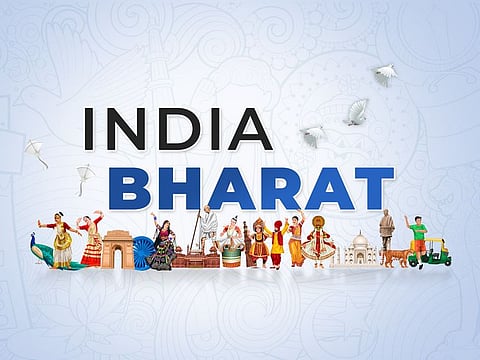The name game: Is Bharat the true heartbeat of India?
The nation’s multifaceted identity includes Bharat, India, Hindustan, and Jambu Dweep

In an unprecedented twist, the name ‘India’ has been swapped out for ‘Bharat’ on Government of India’s official exclusive dinner invitations.
On Tuesday, Indian President Droupadi Murmu sent out the G-20 dinner invites under the title “President of Bharat.”
Close on the heels an official note on Indian Prime Minister Narendra Modi’s visit to Indonesia on Wednesday and Thursday for the 20th ASEAN-India Summit and the 18th East Asia Summit uses the term ‘Prime Minister of Bharat’.
Several Indian media outlets have reported that a potential bombshell could drop later this month during the highly-anticipated five-day special parliamentary session commencing on September 18. What’s keeping everyone on tenterhooks is the government’s silence about the matter.
As a full-fledged debate on this hot-button issue continues, India, a land of diversity and complexity, has historically had a multitude of names, reflecting its rich historical and cultural tapestry.
Among the various monikers that have graced this subcontinent over the ages, four stand out prominently: Jambu Dweep, Bharat, Hindustan, and India. These names, often used interchangeably, reveal not only the country’s historical evolution but also its deep-rooted and variegated identity.
Jambu Dweep: An ancient reference
In the annals of ancient history, India was known as Jambu Dweep/Dvipa, a name steeped in mythology and symbolism. Jambu Dweep, meaning “the continent of the Jambu” or “Jamun (berry) land,” draws its name from the abundance of Jamun trees found across the subcontinent.
The famed Chinese traveller Fa-Hien once described India as a triangular land mass, broad in the north and narrow in the south, resembling the shape of Jamun fruit.
While this name may not be widely used today, it continues to hold significance in some ancient Hindu rituals, preserving a link to India’s distant past.
Also Read: India vs Bharat: Row over G20 dinner invite
Bharat: The indigenous moniker
Of the four names, Bharat stands as the only endonym, a name chosen by the people themselves. It harks back to legendary Emperor Bharat, whose sons are said to have laid the foundation for the nation. This name reflects a deep cultural and historical connection to the land, emphasising India’s indigenous roots.
‘Bharat’ itself is an ancient Sanskrit word that whispers history and culture. Today, the Indian Constitution officially recognises the nation as “the people of India that is Bharat.”
This choice gives precedence to Bharat, aligning with the country’s indigenous identity and shedding the colonial influence.
Hindustan/Hind: The influence of Persia
The names Hind and Hindustan have Arab/Persian origins, introduced by pre-Islamic Persians who struggled to pronounce the Sanskrit “S”. The country was then called “Sindhu”, a reference to the Indus River that flows through the land.
Therefore Sindhu became “Hindu” in Arabic/Persian. This name was adopted to describe the people and regions east of the river.
Even during Muslim rule, the terms Hindustan and Hind encompassed both Hindus and Muslims, highlighting their shared geographical identity rather than religious differences. The Indo-Iranian hybrid “Hindustan” remains in some use today, symbolising the nation’s shared history.
India: The global brand
The name “India” has its own fascinating history with twists, turns, and linguistic quirks. Back in the day, India was also known as Sindhu, named after the mighty Indus River. The Greeks were among the first to coin the term “Indía” to describe the land beyond the Indus River.
However “India” also had its moment in Old English, hanging out between the mid-5th century and the mid-12th century AD. Subsequently during the British Raj, the word “India” became synonymous with wealth.
Over time, it gained broader acceptance, particularly as the British mapmakers began using it more frequently. Today, “India” remains the most commonly recognised name on the international stage.
India’s diverse identities, encapsulated in the names Jambu Dweep, Bharat, Hindustan, India, and other little known monikers underscore the rich tapestry of its history and culture.
Each name carries its own significance, from the mythological roots of Jambu Dweep to the indigenous pride of Bharat, the rich Arab/Persian influence of Hind/Hindustan, and the globally recognised brand India.
While the debate may continue about which name best represents the nation, India’s ability to embrace this diversity is a testament to its multifaceted identity, rich character and historical resilience.
Sign up for the Daily Briefing
Get the latest news and updates straight to your inbox






